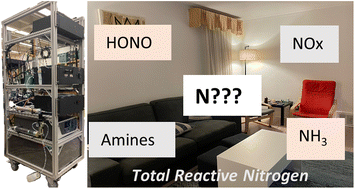Emerging investigator series: an instrument to measure and speciate the total reactive nitrogen budget indoors: description and field measurements†
Abstract
Reactive nitrogen species (Nr), defined here as all N-containing compounds except N2 and N2O, have been shown to be important drivers for indoor air quality. Key Nr species include NOx (NO + NO2), HONO and NH3, which are known to have detrimental health effects. In addition, other Nr species that are not traditionally measured may be important chemical actors for indoor transformations (e.g. amines). Cooking and cleaning are significant sources of Nr, whose emission will vary depending on the type of activity and materials used. Here we present a novel instrument that measures the total gas-phase reactive nitrogen (tNr) budget and key species NOx, HONO, and NH3 to demonstrate its suitability for indoor air quality applications. The tNr levels were measured using a custom-built heated platinum (Pt) catalytic furnace to convert all Nr species to NOx, called the tNr oven. The measurement approach was validated through a series of control experiments, such that quantitative measurement and speciation of the total Nr budget are demonstrated. The optimum operating conditions of the tNr oven were found to be 800 °C with a sampling flow rate of 630 cubic centimetres per minute (ccm). Oxidized nitrogen species are known to be quantitatively converted under these conditions. Here, the efficiency of the tNr oven to convert reduced Nr species to NOx was found to reach a maximum at 800 °C, with 103 ± 13% conversion for NH3 and 79–106% for selected relevant amines. The observed variability in the conversion efficiency of reduced Nr species demonstrates the importance of catalyst temperature characterization for the tNr oven. The instrument was deployed successfully in a commercial kitchen, a complex indoor environment with periods of rapidly changing levels, and shown to be able to reliably measure the tNr budget during periods of longer-lived oscillations (>20 min), typical of indoor spaces. The measured NOx, HONO and basic Nr (NH3 and amines) were unable to account for all the measured tNr, pointing to a substantial missing fraction (on average 18%) in the kitchen. Overall, the tNr instrument will allow for detailed survey(s) of the key gaseous Nr species across multiple locations and may also identify missing Nr fractions, making this platform capable of stimulating more in-depth analysis in indoor atmospheres.

- This article is part of the themed collections: Environmental Science: Processes & Impacts Recent HOT Articles, Atmospheric chemistry, Emerging Investigator Series, Outstanding Papers 2023 – Environmental Science: Processes & Impacts and Indoor Air Quality


 Please wait while we load your content...
Please wait while we load your content...